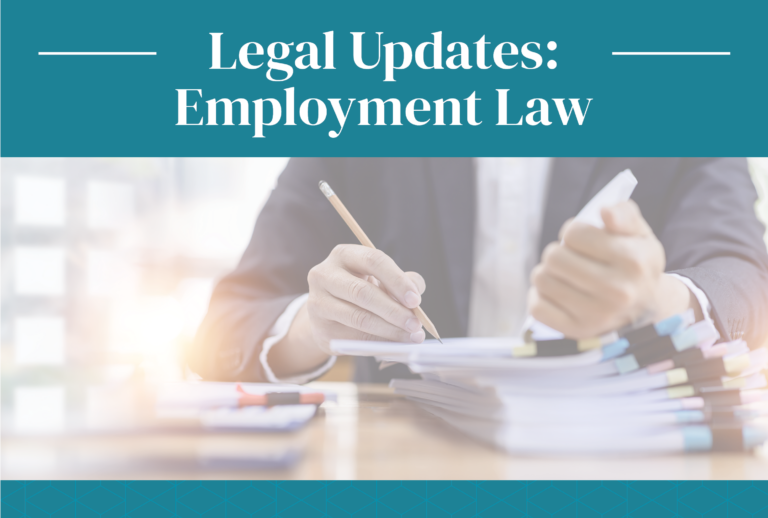May 8th, 2020
Reopening Your Business? Here’s What You Need to Know About Bringing Your Workforce Back During COVID-19
Posted in: Employment Law Tagged: Coronavirus, Darla J. McClure

For businesses which have either temporarily closed their doors or have employees working remotely, now is the time to begin preparing for your workforce to come back to the office. Returning to the office means that employers must carefully consider and balance the health and safety of their employees while maintaining operations. The following are various legal considerations employers may face when discussing how to reopen and moving forward in this “new normal.”
Office Safety Procedures
A key consideration in bringing back your employees is doing so in a manner that ensures their safety. It is recommended that employers follow the Centers for Disease Control and Prevention (CDC) guidelines regarding social distancing and personal protective equipment. Specifically, the CDC advises that every person wear a mask when out in public, including in the office around others, and maintain a minimum distance of six feet from other persons. This may require the employer to reevaluate office configurations and make necessary adjustments so that employees are able to work and maintain a safe distance from one another. Following CDC guidelines is not only important to keep employees safe, but it will also help to defend against any claims of negligence if an employee gets sick and attempts to attribute his/her sickness to the employer.
Another way to safeguard staff is to require employees to submit to temperature testing prior to entering the workplace. This requirement has raised many legal concerns. The Equal Employment Opportunity Commission (EEOC) has issued guidance indicating that an employer does not violate the Americans with Disabilities Act (ADA) for taking employee temperatures. Specifically, the ADA, along with other anti-discrimination laws, does not interfere with, or prevent employers from following, the guidelines and suggestions issued by the CDC or state and local public health authorities regarding COVID-19.
Additionally, employers are permitted to screen employees, and should rely on the CDC, other public health authorities, and medical professionals, for guidance in identifying symptoms associated with COVID-19. For example, employers may ask employees if they have a fever, cough, chills, loss of smell or taste, and symptoms such as gastrointestinal problems. The answers to these questions may help employers decide whether it is safe to allow employees to come to the workplace or require them to stay at home as their attendance could pose a direct threat to the health of others in the workplace. Any medical information received from an employee, including temperature readings, should be kept confidential and maintained on a log kept in a separate file for each employee.
Employee Concerns
Regardless of all the safety measures an employer puts in place, employees may still feel unsure about coming back to work. Of concern are those employees with qualified disabilities under the ADA and who may be considered high-risk (i.e. they are over the age of 65 and/or have compromised immune systems). It is likely that some of these high-risk individuals may request reasonable accommodations which would make them feel safe to return to work. Reasonable accommodations for employees who request reduced contact with others due to a disability may include, but are not limited to:
- Changes to the workplace such as using plexiglass.
- Designating one-way corridors.
- Continuation of virtual meetings or such other accommodations that reduce chances of contact that could result in exposure to the virus.
- Modifying an employee’s work schedule which could permit an employee with a disability to perform the essential functions of the job while reducing exposure to COVID-19.
- Lastly, for those who have positions that allow them to telework, this is still considered one of the best options.
Notwithstanding, a disabled employee and the employer should still go through the “interactive process” to determine what makes the most sense for the employee who is returning to work.
A more difficult concern and likely issue to arise is how an employer should handle an employee’s request to continue teleworking simply because the employee does not feel safe coming back to work. From a legal standpoint, once an employer has decided to reopen and has provided for the necessary and highly recommended safety precautions, an employer has the right to require its employees to come back to work. If permitted, an employee could use any accrued leave to prolong a stay at home. Otherwise, if the employee has no particular legal rights and you need him/her in order to operate your business, you could terminate the employment relationship if the employee refuses to come to work. This is true for employees who are currently receiving unemployment benefits and refuse to come back to work once they have been advised that they can return. Employers should also know that the Unemployment Division may require employers to provide notification if an employee is offered a return to work and the employee has declined the offer as that might render the employee ineligible for benefits.
While there may not be legal consequences arising from terminating an employee who refuses to return to work, an employer should take into consideration the practical solutions of dealing with this scenario. Remember, your employees are in a difficult situation right now and they may continue to be afraid of getting sick. Employers may wish to allow employees to continue to work from home for a bit longer and then allow them to ease into coming back starting on a part-time basis or by having employees come back in shifts to the extent reasonable and practical. Regardless, an employer should make sure it is handling employee requests appropriately so it will need to ask the employee why he/she is unable to come back to work. If the failure to return is due to child care issues, the employee may be eligible for expanded Family and Medical Leave. Under this new law, employers are required to pay the employee 2/3rd of salary for a period of 10 weeks up until December 31, 2020.
Communication with your employees during this time is imperative. Employers should reassure employees that their health is a top priority and provide them with information about all of the safety measures being taken. Each worksite is different and will implement solutions that work for keeping appropriate distancing. Employers should also inform returning employees of enhanced cleaning being done to the workplace as well as reminding them of the importance of staying home if they do not feel well, continuing frequent hand-washing and avoiding touching eyes, nose and mouth.
You can find more on issues affecting businesses and individuals in our COVID-19 Resource Center.







